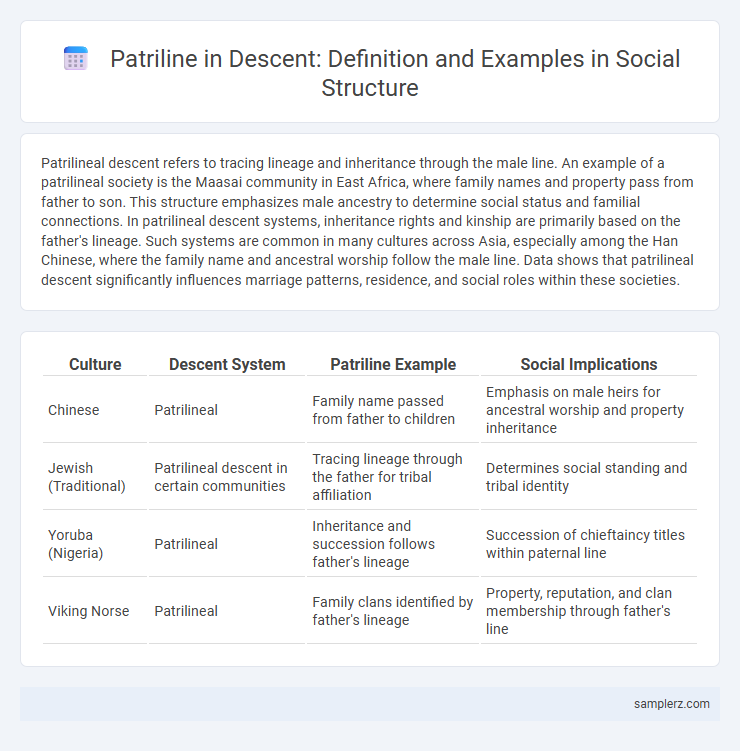Patrilineal descent refers to tracing lineage and inheritance through the male line. An example of a patrilineal society is the Maasai community in East Africa, where family names and property pass from father to son. This structure emphasizes male ancestry to determine social status and familial connections. In patrilineal descent systems, inheritance rights and kinship are primarily based on the father's lineage. Such systems are common in many cultures across Asia, especially among the Han Chinese, where the family name and ancestral worship follow the male line. Data shows that patrilineal descent significantly influences marriage patterns, residence, and social roles within these societies.
Table of Comparison
| Culture | Descent System | Patriline Example | Social Implications |
|---|---|---|---|
| Chinese | Patrilineal | Family name passed from father to children | Emphasis on male heirs for ancestral worship and property inheritance |
| Jewish (Traditional) | Patrilineal descent in certain communities | Tracing lineage through the father for tribal affiliation | Determines social standing and tribal identity |
| Yoruba (Nigeria) | Patrilineal | Inheritance and succession follows father's lineage | Succession of chieftaincy titles within paternal line |
| Viking Norse | Patrilineal | Family clans identified by father's lineage | Property, reputation, and clan membership through father's line |
Understanding Patrilineal Descent: Key Concepts
Patrilineal descent traces lineage exclusively through the male line, emphasizing inheritance, family name, and property transmission from father to son. This system is prevalent in many societies, including traditional Chinese and Arab cultures, where ancestral identity and social status are linked to paternal ancestry. Understanding patrilineal descent reveals how kinship and social organization prioritize male lineage for continuity and heritage.
Historical Examples of Patrilineal Societies
The ancient Spartans are a notable example of a patrilineal society where lineage and inheritance were traced through the male line, reinforcing warrior status and property rights among males. In traditional Chinese society, patrilineal descent governed family structure and succession, emphasizing ancestral worship and male lineage continuity. Similarly, the Maasai of East Africa practiced patrilineal descent to establish clan membership, land ownership, and social roles within their semi-nomadic communities.
Patrilineal Descent in Tribal Communities
Patrilineal descent in tribal communities is a kinship system where lineage, inheritance, and social identity are traced through the male line, often shaping clan membership and leadership roles. This system is prevalent among many indigenous groups in Africa, Asia, and Native American tribes, reinforcing male authority and property transmission within the paternal lineage. Patrilineal descent establishes distinct social structures that influence marriage patterns, residence, and group cohesion in these societies.
Patrilineal Family Structures Across Cultures
Patrilineal family structures, where descent and inheritance are traced through the male line, are prevalent in many societies, including traditional Chinese, Arab, and Maasai cultures. In these systems, family names, property, and social status typically pass from father to son, reinforcing male authority and lineage continuity. Anthropological studies reveal that patrilineal descent shapes kinship networks, inheritance practices, and residence patterns across diverse cultural contexts.
The Role of Surnames in Patrilineal Lineages
Surnames serve as crucial markers in patrilineal lineages, passing from father to offspring to signify belonging to a specific paternal ancestry. In many cultures, these surnames preserve family heritage and reinforce male lineage continuity across generations. This system helps maintain social identity and inheritance rights tied directly to the paternal line.
Patrilineal Inheritance: Property and Titles
Patrilineal inheritance determines the transfer of property and titles exclusively through the male lineage, often prioritizing sons as primary heirs. In many traditional societies, estates, family names, and noble titles pass from father to eldest son, reinforcing patriarchal structures and ensuring the continuity of family wealth and status. This system impacts social organization by concentrating resources and authority within patrilineal kin groups, influencing marriage alliances and lineage identity.
Modern Manifestations of Patrilineal Descent
Modern manifestations of patrilineal descent are evident in inheritance laws and surname practices that prioritize the male lineage. Many contemporary societies maintain property and family name transmission exclusively through the father's line, reflecting enduring patrilineal traditions. Corporate and legal frameworks in some cultures continue to reinforce patrilineal descent by favoring male heirs in succession and estate rights.
Patrilineage and Social Identity
Patrilineage shapes social identity through the transmission of family name, inheritance rights, and kinship obligations along the male line, reinforcing group cohesion and continuity. In societies with patrilineal descent, individuals derive status and social roles primarily from their paternal ancestors, influencing marriage alliances and community leadership. This system often dictates residence patterns and resource distribution, embedding social identity within the broader framework of male lineage and lineage-based social networks.
Patrilineal Descent in Religious Traditions
Patrilineal descent is a crucial aspect of kinship in many religious traditions, such as Judaism and Islam, where lineage and inheritance are traced through the male line. In Judaism, Jewish identity is traditionally passed down patrilineally in some communities, while religious status often follows the father's line. Similarly, Islamic law emphasizes patrilineal descent for determining inheritance, family name, and tribal affiliation, reinforcing social and religious identity through male lineage.
Challenges and Changes in Patrilineal Systems
Patrilineal descent systems often face challenges such as evolving gender roles, increased urbanization, and legal reforms that contest traditional inheritance practices. Changes in these systems include the gradual recognition of maternal rights and the decline of male-exclusive lineage tracing in favor of more inclusive family structures. Social mobility and globalization further complicate strict patrilineal norms, prompting communities to adapt their cultural practices.

example of patriline in descent Infographic
 samplerz.com
samplerz.com